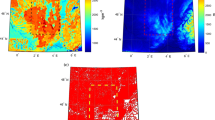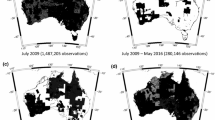Abstract
Compilation of the bathymetrically and topographically corrected gravity disturbance, the so called BT disturbance, for the purpose of gravity interpretation/inversion, is investigated from the numerical point of view, with special emphasis on regions of negative heights. In regions of negative ellipsoidal (geodetic) heights, such as the Dead Sea region onshore or offshore areas of negative geoidal heights, two issues complicate the compilation and subsequently the inversion of the BT disturbance. The first is associated with the evaluation of normal gravity below the surface of the reference ellipsoid (RE). The latter is tied to the legitimacy of the harmonic continuation of the BT disturbance in these regions. These two issues are proposed to be resolved by the so called reference quasi-ellipsoid (RQE) approach. New bathymetric and topographic corrections are derived based on the RQE and the inverse problem is formulated based on the RQE. The RQE approach enables the computation of normal gravity by means of the international gravity formula, and makes the harmonic continuation in the regions of negative heights of gravity stations legitimate. The gravimetric inversion is then transformed from the RQE approach back to the RE approach, following the now legitimate harmonic upward continuation of the gravity data to stations on or above the RE. Stripping, the removal of an effect of a known density contrast, is considered in the context of the RQE approach. A numerical case study is presented for the RQE approach in a region of NW Canada.
Similar content being viewed by others
References
Heiskanen W.A. and Moritz H., 1967. Physical Geodesy. Freeman and Co., San Francisco.
Hofmann-Wellenhof B. and Moritz H., 2006. Physical Geodesy, Second Edition. Springer Verlag, Wien, NewYork.
Ivan M., 1994. Upward continuation of potential fields from a polyhedral surface. Geophys. Prospect., 42, 391–404.
Lemoine F.G., Kenyon S.C., Factor J.K., Trimmer R.G., Pavlis N.K., Chinn D.S., Cox C.M., Klosko S.M., Luthcke S.B., Torrence M.H., Wang Y.M., Williamson R.G., Pavlis E.C., Rapp R.H. and Olson T.R., 1998. The Development of the Joint NASE GSFC and the National Imagery and Mapping Agency (NIMA) Geopotential Model EGM96. National Aeronautics and Space Administration, Goddard Space Flight Center, Greenbelt, Maryland, USA.
Meurers B. and Vajda P., 2006. Some aspects of Bouguer gravity determination-revisited. Contributions to Geophysics and Geodesy, 36, 99–112.
Mikuška J., Pašteka R. and Marušiak I., 2006. Estimation of distant relief effect in gravimetry. Geophysics, 71, J59–J69, doi: 10.1190/1.2338333.
Moritz H., 1968. Density Distributions for the Equipotential Ellipsoid. Report 115, Department of Geodetic Science, The Ohio State University, Columbus, Ohio.
Moritz H., 1973. Ellipsoidal Mass Distributions. Report No. 206, Department of Geodetic Science, The Ohio State University, Columbus, Ohio.
Moritz H., 1990. The Figure of the Earth. Wichmann Verlag, Karlsruhe, Germany.
Novák P. and Grafarend E.W., 2005. Ellipsoidal representation of the topographical potential and its vertical gradient. J. Geodesy, 78, 691–706, doi: 10.1007/s00190-005-0435-4.
Tscherning C.C. and Sünkel H., 1981. A method for the construction of spheroidal mass distributions consistent with the harmonic part of the Earth’s gravity potential. Manuscr. Geod., 6, 131–156.
Vajda P., Vaníček P., Novák P. and Meurers B., 2004. On evaluation of Newton integrals in geodetic coordinates: Exact formulation and spherical approximation. Contributions to Geophysics and Geodesy, 34(4), 289–314.
Vajda P., Ellmann A., Meurers B., Vaníček P., Novák P. and Tenzer R., 2008. Global ellipsoid-referenced topographic, bathymetric and stripping corrections to gravity disturbance. Stud. Geophys. Geod., 52, 19–34.
Vaníček P., Sun W., Ong P., Martinec Z., Najafi M., Vajda P. and ter Horst B., 1996. Downward continuation of Helmert’s gravity. J. Geodesy, 71, 21–34, doi 10.1007/s001900050072.
Vaníček P., Novák P. and Martinec Z., 2001. Geoid, topography, and the Bouguer plate or shell. J. Geodesy, 75, 210–215, doi 10.1007/s001900100165.
Author information
Authors and Affiliations
Corresponding author
Rights and permissions
About this article
Cite this article
Vajda, P., Ellmann, A., Meurers, B. et al. Gravity disturbances in regions of negative heights: A reference quasi-ellipsoid approach. Stud Geophys Geod 52, 35–52 (2008). https://doi.org/10.1007/s11200-008-0004-4
Received:
Revised:
Accepted:
Published:
Issue Date:
DOI: https://doi.org/10.1007/s11200-008-0004-4




